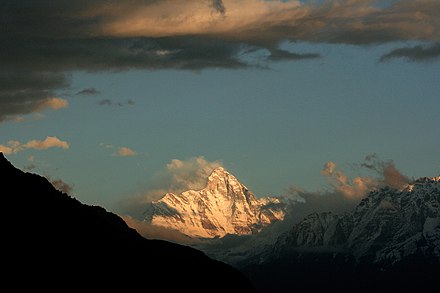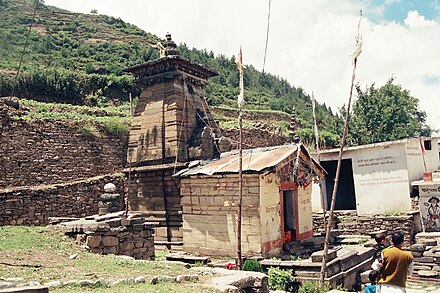Nanda Devi National Park - national park in India
 Nanda Devi National Park is in Garhwal, northern India. It is named after the highest mountain entirely in India and has been inscribed on the UNESCO World Heritage list.
Nanda Devi National Park is in Garhwal, northern India. It is named after the highest mountain entirely in India and has been inscribed on the UNESCO World Heritage list.
Understand
History
The park has been a since 1988.
Landscape and people
 The landscape is dominated by mountains. The park contains or is delimited by 24 peaks at least 6,000 m above the sea level. Nanda Devi is 7,816 m high.
The landscape is dominated by mountains. The park contains or is delimited by 24 peaks at least 6,000 m above the sea level. Nanda Devi is 7,816 m high.
The area is inhabited by the indigenous Bhotiya tribal community. There are 22 villages in the Niti Valley region on the periphery of the park. A majority of the villages practice transhumance—i.e. they will live for six months in the upper villages, and move down to winter villages to avoid the extreme climate. Bhotiyas are a closely knit society and still practice their traditional customs and rituals. Village Lata is famous for its week-long Mask Dance festival observed during the second week of April every year. There are places of archaeological interest in the Niti Valley, and a 12th-century temple of Nanda Devi in the village of Lata.
The native Bhotiya community was in the forefront of Chipko Movement during the 1970s. The prompt action taken by Gaura Devi and few other village women is a milestone in the non-violent struggle of tribal communities in saving their forest wealth. The political leadership in Niti Valley Painkhanda region was provided by Comrade Govind Singh Rawat.
Flora and fauna
Wildlife in the park includes snow leopards, black and brown bears, tahrs, deer, musk deer and monkeys. Over 100 species of birds and 312 floral species have been documented.
Climate
Get in
The closest cities are Joshimath northwest of the park and Munsyari southeast of the park. The best access route is via Haridwar, from where you drive to Rishikesh, Srinagar, Rudraprayag, Karnprayag, Chamoli and Joshimath. Village Lata, the gateway to the Nanda Devi National Park, is 25 km upstream from Joshimath on Niti-Malari highway. Another route is from Kathgodam from Kumaon side. The route from Kathgodam covers Almora, Kausani, Baijnath, Gwaldam and meets at Karnprayag. The nearest airport is in Dehradun, which is 14 km from Rishikesh.
Fees and permits
The DFO Joshimath issues permits for trekking inside the park.
Get around
See
The Interpretation Center on Bio-Cultural Diversity of Niti Valley at Lata Village provides a detailed history exploration, mountaineering, Chipko and post Chipko movement and also showcases a vide range of traditional cultural artefacts.
Do
- Nanda Devi National Park Interpretive Trek (Nanda Devi Trek), Shepherds Lodge Devangan, Thuaa, V&P Lata, Chamoli (4 days of trek from Lata village), +918006872193, ndi.kuflon@gmail.com. This trek is managed by the local community and starts from the village of Lata and culminates at Suraithota. The visitors camp at Kanook and Lata Kharak while at the village of Tolma homestay arrangements are made. The highest elevation gained during the trek is . Since the landscape is almost vertical, chances of AMS remains high. The trekkers camp midway at Camp Kanook, between Lata village and Lata Kharak, to acclimatise before attempting the high altitude. The Nanda Devi Trek is planned as an all immersive experience for travellers. 2018-12-15
Buy
Eat
Drink
Sleep
Lodging
- Shepherds Lodge Devangan (Latu Ka Lodge), Thuaa, Village Lata (Drive 25 Km upstream from Joshimath on Niti Malari Road), +91 9761188401, bhotiya@gmail.com. Check-in: noon, check-out: 11AM. The lodge is an ideal base for trekkers planning to explore the bio-culture diversity and mesmerising landscape and wilderness of the park. The tariff includes dinner and breakfast. There is an equipment store for hiring trekking equipment 2018-12-15
Camping
Backcountry
Stay safe
The terrain in Nanda Devi National Park is almost vertical. Therefore, altitude sickness is definitely a risk while trekking in the park. It is advisable to strictly follow best practices, especially an acclimatisation drill, and carry enough woolens, water, emergency rations and medicine kit. Avoid zipped itineraries that propose trekking straight to Lata Kharak in a single day. Most of the health issues in the Nanda Devi National Park region are due to rapid altitude gain.
Go next
Nanda Devi National Park
euttaranchal.com/tourism/nanda-devi-national-park.phpTimezone:MultipleCoordinates:30.42, 79.85